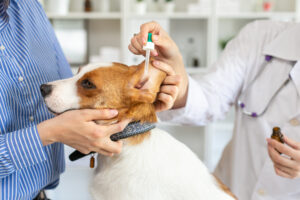
Although it’s not an enjoyable experience, your pet must wear their E-collar following the vet’s recommendations.
Pet parents everywhere can agree that watching your dog endure an injury or surgical procedure can be difficult and emotionally exhausting. Bringing your companion home from the veterinarian wearing an E-collar only adds more stress to the situation, and keeping it on during the recovery process can be as overwhelming for you as it is for your dog. Although it’s not an enjoyable experience, your pet must wear their E-collar following the vet’s recommendations. Keep reading for some tips on helping your pet heal with an E-collar.
When Your Pet Needs an E-Collar
Elizabethan Collars, or E-collars for short, are generally used to stop your pet from licking, biting, or scratching at the surgery site or stitches. A dog’s natural instinct is to lick its wound to heal its injury. However, licking their wound or biting their skin could cause your pet to unintentionally rip out their stitches, which could damage the incision and introduce bacteria into the wound, which could cause a secondary infection. In general, this interrupts the healing process. The heightened risk for infection can be especially problematic with orthopedic procedures where implants (metal plates, screws, and/or pins) are present.
Keeping Your Pet from Bumping into Things
The collar restricts your dog’s peripheral vision and initially causes difficulty for many pets when walking in tight or narrow spaces. Running into objects they can’t see, such as things that may fall over and make sudden noises, can be frightening for your furry friend. You can ease their stress by initially keeping your dog in a confined space with no small objects that would move if knocked. Also, be sure to move any precious valuables in your house to higher shelves.
Eating and Drinking with an E-Collar
If your pet is having difficulty eating or drinking with the E-collar on, try putting their food and water on a flat plate instead of their usual dish. You can also try elevating the dish, making it easier to reach. If nothing is working and you feel you have to remove the E-collar to let your dog eat and drink, consult your veterinarian for advice. You must watch your pet closely while the collar is off and replace it as soon as they are finished.
Types of E-Collars
There are numerous types of Elizabethan collars available for purchase. Typically, the age-old “cone of shame” is a standard in veterinary medicine because of its effectiveness. Some patients may require the use of a different type of barrier in lieu of or in addition to a traditional Elizabethan collar. Please discuss options with your veterinary team before removing an e-collar.
Trust Maryland Veterinary Surgical Services With Your Companion’s Health
Your companion’s health is important, and the team at MVSS is ready to provide the best care possible for your furry family. We are dedicated to combining comprehensive exams and assessments with informative and honest discussions of your companion’s care. Once we have worked with you to decide on the best course of action for your dog, our professionals will use their surgical expertise to work towards the goal of giving your companion an active and pain-free life. We are proud to serve loyal companions in Catonsville and Baltimore. To learn more about our services, give us a call at 410-788-4088 or visit us online. For more information and tips for pet health, follow us on Facebook and Pinterest.
